The Friends of the Wildflower Garden, Inc.
Plants of the Eloise Butler Wildflower Garden
The oldest public wildflower garden in the United States
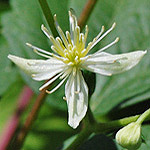
Common Name
Virgin's Bower (Old Man's Beard, Devil's Darning Needles, Wild Hops)
Scientific Name
Clematis virginiana L.
Plant Family
Buttercup (Ranunculaceae)
Garden Location
Upland
Prime Season
Early Summer to Early Autumn Flowering
Virgin's Bower is a native perennial twining vine which you will usually spot via its' flowers which will be lying atop other vegetation. The stems can grow to over 9 feet long and become woody with age. They are green when young with some reddish tints, turning brown with age. Stems are square-like near branch junctions.
The leaves are opposite, with 3 ovate leaflets (sometimes 5), coarsely toothed or lobed and with pointed tips. Leaf stalks twist around other objects for support.
The inflorescence is a stalked branched panicle, somewhat flat-topped, rising from the leaf axils.
Flowers: Virgin's Bower can be dioecious, that is male (staminate) and female (pistillate) flowers are on separate plants or perfect flowers can be on the same plant. All will have four white or cream color sepals (there are no petals) that spread widely but do not recurve and have very fine hair. Male flowers have numerous stamens with white filaments, crooked at the end, and with pale yellow anthers. Separate female flowers have numerous greenish pistils in the center with curly styles. There may also be a few false stamens (Staminodes). Perfect flowers will have only several pistils along with two rows of stamens.
Seed: In the fall the seed head is a set of beard-like tufts of hairy plumed achenes with persistent elongated styles, hence the other common name of "Old Man's Beard". The achenes are brown to dark brown, a flattened ovoid shape with a rough surface. Seeds require 30 days of cold stratification for germination and are best planted outside in the fall and let Winter do the work.
Habitat: The plant can be trained to grow on a trellis in the home garden. It does require full sun, moderate moisture (wet-mesic to mesic) and it can become invasive. You will find it in many places in the Upland Garden. Certain species of Clematis, particularly C. flammula (Sweet-scented Virgins Bower) are poisonous as they contain an alkaloid, Clematine, which is a violent poison. C. virginiana is not known to be particularly hazardous but care should be taken in handling it.
Names: Clematis in the Greek, Klematis, refers to climbing plants. The species, virginiana, refers to 'of Virginia' the state named after the English virgin queen, Elizabeth I. The common name, Virgin's Bower, is believed to come from the flowers which, when abundant, can form a cascade of white - white being a plant color referencing virginity. The author name 'L.' is for Carl Linnaeus (1707-1778), Swedish botanist and the developer of the binomial nomenclature of modern taxonomy. The other common name of 'Devil's Darning Needles' probably refers to the persistent curved style on the seed, or possibly to the hooked ends of the stamens.
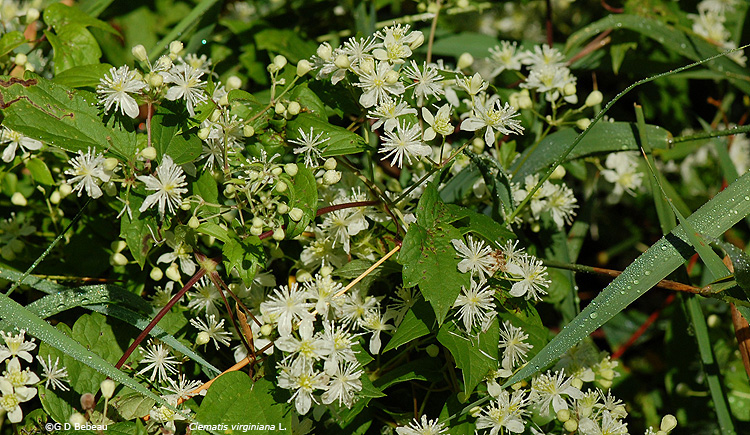
Above: Virgin's Bower trailing across other plants and putting on quite a show.
Below: 1st photo - The flowers have long stamens with a crook on the end from which comes "Devil's Darning Needles". It blooms from late June until late August. 2nd photo - The inflorescence is somewhat flat-topped branched panicle.
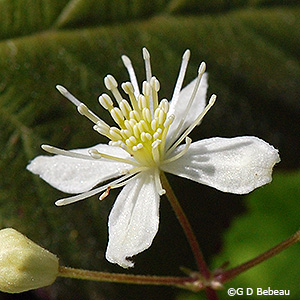
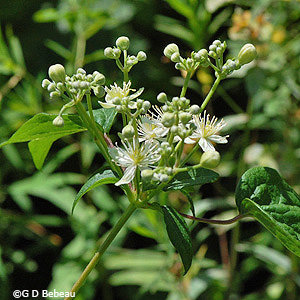
Below: 1st photo - Leaves have 3 ovate leaflets (sometimes 5), coarsely toothed or lobed. 2nd photo - Stems take on a reddish tint with age and are more square where they branch.
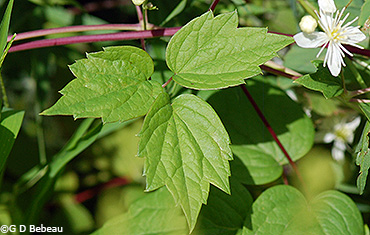

Below: In Autumn the plumed achenes (single seeded fruits) are quite visible, from which comes the name "Old Man's Beard".

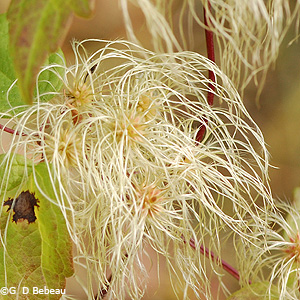
Below: 1st photo - The achenes with the long curved style still attached. [Photo ©Steve Hurst, USDA-NRCS Plants Database.] 2nd photo - For comparison - Western Blue Virgin's Bower - the only other wild Clematis found in Minnesota [Photo ©Emmett J. Judziewitz, Wisconsin Flora.]

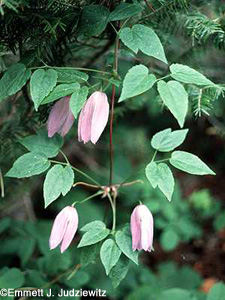
Notes: Eloise Butler's records show that she collected plants of this species on Sept. 17, 1907 in Minneapolis on 4th Ave. between 24 and 25th Street. On July 11, 1911 she noted that it was also already growing in the Garden, but added plants in 1916 also. It is listed on Martha Crone's 1951 census of Garden plants. In 1938 Martha Crone recorded in her log that the plant bloomed on May 2nd, and May 9 in 1939, which must be close to a record early bloom dates. She planted it in 1947 and 1949 when she developed the Upland Garden. It is found widely across Minnesota but not in all counties. It is the most widespread of the three wild Clematis in the Eastern half of the United States, it's range extending as far west as the Dakotas, Nebraska and Kansas. Of these three, two are present in Minnesota, this one and "Purple Virgin's Bower" or also called "Western Blue Virgin's Bower", C. occidentalis, which was originally planted in the Garden by Eloise Butler in 1913 but is no longer extant and is actually quite rare in Minnesota.
Read Dora Reed Goodale's poem on The Wild Clematis.
Return to -- Site Plan/Archive Index --or-- List of Common Plant Names -- or -- List of Scientific Names -- or --Home Page - - - Back to top.
References: Plant characteristics are generally from sources 1A, 32, W2, W3, W7 & W8 plus others as specifically applied. Distribution principally from W1, W2 and 28C. Planting history generally from 1, 4 & 4a. Other sources by specific reference. See Reference List for details.
 Identification booklet for most of the flowering forbs and small flowering shrubs of the Eloise Butler Wildflower Garden. Details Here.
Identification booklet for most of the flowering forbs and small flowering shrubs of the Eloise Butler Wildflower Garden. Details Here.
©2013
Friends of the Wildflower Garden, Inc. Text and photos are by G. D. Bebeau unless otherwise credited. "www.friendsofeloisebutler.org"
041720